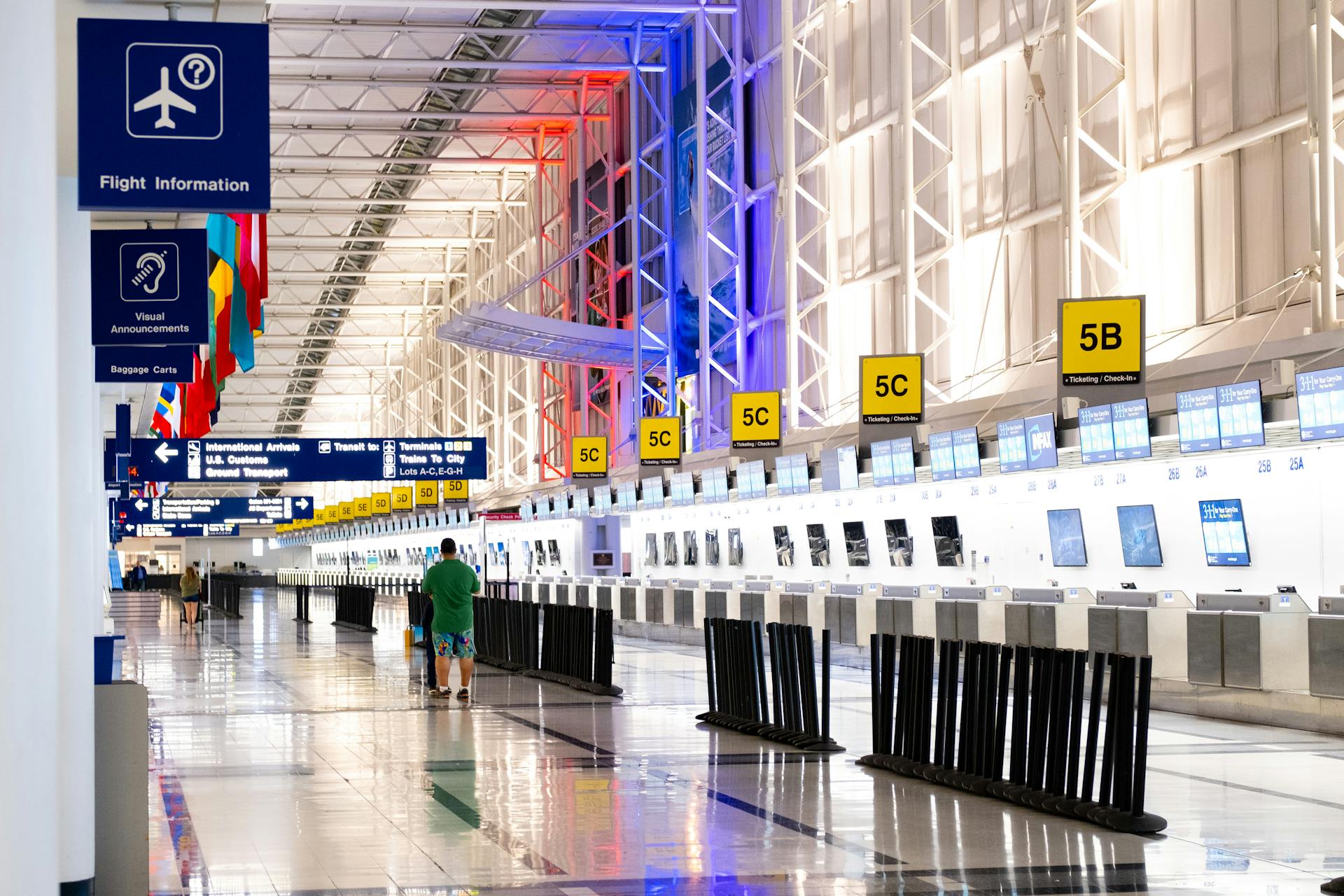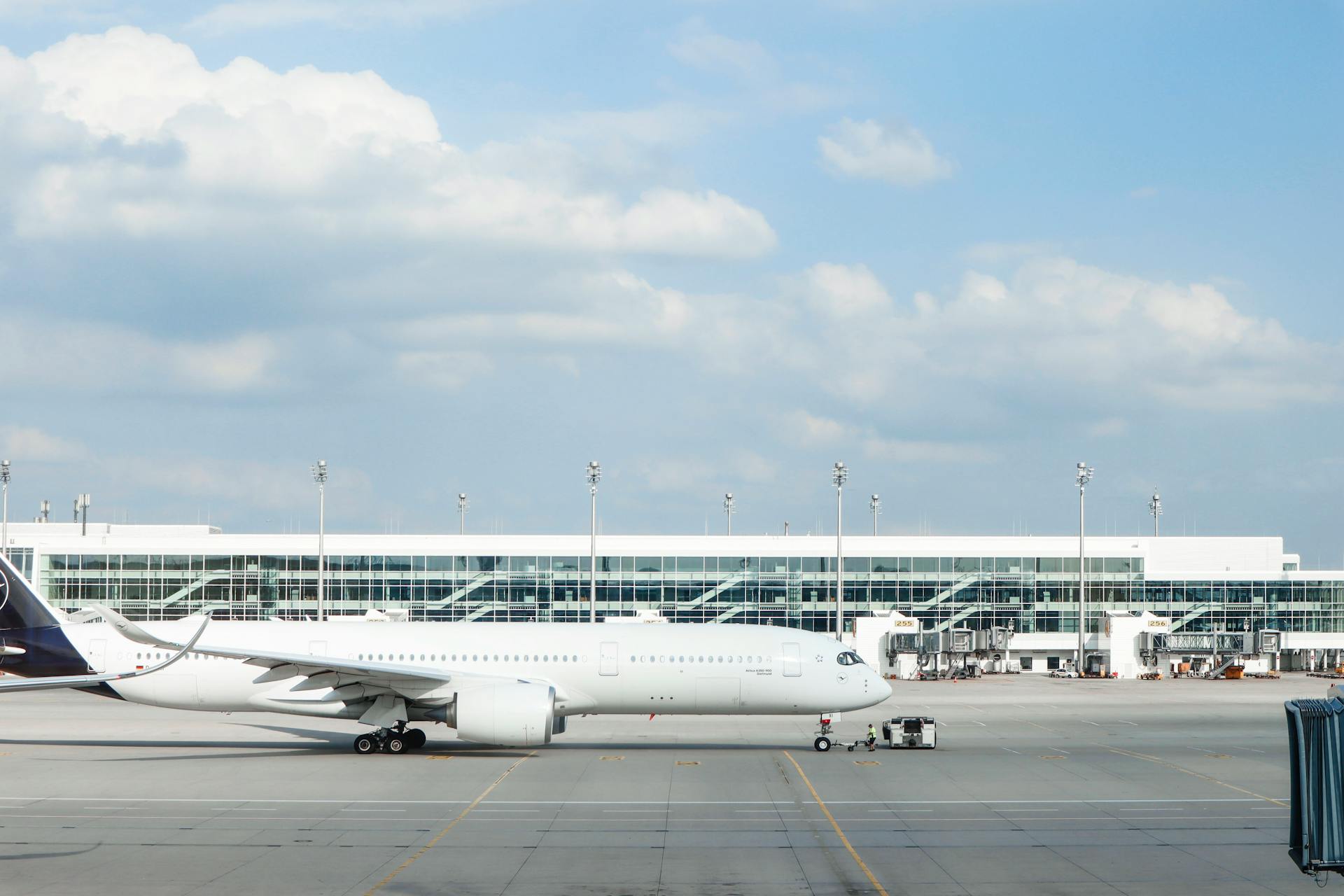
The Gwadar Airport in Pakistan is a game-changer for the country's economy. It's strategically located on the Arabian Sea, providing a direct link to the Middle East and Central Asia.
This airport has the potential to boost trade and commerce in the region, connecting Pakistan to major international markets. It's expected to increase economic activity in the area.
The airport's construction was completed in 2013, and it's been operational since then. It's a significant investment for the country's infrastructure development.
The Gwadar Airport is expected to attract foreign investment and create new job opportunities, contributing to the country's economic growth.
History of Gwadar Airport
The history of Gwadar Airport dates back to 1958 when the Government of Pakistan bought Gwadar from Muscat's Sultan.
Air operations started in 1966, and the airport gained international status with two weekly flights from Karachi to Muscat via Gwadar.
The terminal building was inaugurated in 1984, and the airport was established as a domestic airport, considered the biggest in Balochistan.

The airport mainly caters to the population of Gwadar, with Pakistan International Airlines connecting it to several cities in Pakistan and abroad.
Other airlines, such as Oman Air and airblue, have also launched flights to Gwadar, making it a significant hub for air travel in the region.
In 2014, the airport project was launched as a high-priority initiative within the China-Pakistan Economic Corridor (CPEC) programme.
The new airport, named after Feroz Khan Noon, was opened on 14 October 2024, in a ceremony led by Prime Minister Shehbaz Sharif and Chinese Premier Li Qiang.
The airport's first international flight took place on 10 January 2025, with a flight to Muscat, the capital of Oman.
The airport became fully operational on 20 January 2025, and in late January, the first Airbus aircraft, an Airbus A319, landed at the airport's runway 25.
Here's a brief timeline of the airport's major milestones:
- 1958: Government of Pakistan buys Gwadar from Muscat's Sultan.
- 1966: Air operations start.
- 1984: Terminal building inaugurated.
- 2014: Airport project launched within CPEC programme.
- 14 October 2024: New airport opens.
- 10 January 2025: First international flight takes place.
- 20 January 2025: Airport becomes fully operational.
Airport Development
The New Gwadar International Airport was constructed at a cost of Rs55.4 billion, funded mainly as a grant by China with participation from Pakistan and Oman.
China contributed a significant 67% of the funding, which speaks to the strong economic ties between the two countries.
The airport's development was a collaborative effort, with Pakistan and Oman also playing important roles in its construction.
Construction Timeline

Airport development is a complex process that requires careful planning and execution.
The construction timeline for an airport typically begins with the planning phase, which can take anywhere from 2 to 5 years.
During this phase, the airport's layout and design are finalized, and the necessary permits are obtained.
The construction phase can take anywhere from 5 to 10 years, depending on the size and scope of the project.
Airport expansion projects can be divided into three main stages: land acquisition, design and planning, and construction.
Land acquisition can take up to 2 years, while design and planning can take up to 3 years.
The construction phase is usually the longest part of the process, taking up to 5 years to complete.
Airport development projects are often carried out in phases, with each phase building on the previous one.
This allows for the airport to remain operational during the construction process, minimizing disruptions to passengers and airlines.
If this caught your attention, see: Trade Development Authority of Pakistan
Construction Updates
The New Gwadar International Airport is a significant development in the region, and I'm excited to share some construction updates with you. It was built to replace the existing airport and was opened on 14 October 2024.
The airport occupies a massive 4,300 acres of land, which is roughly 17 square kilometers. It's located in Gurandani, 26 km north-east of the existing airport in Gwadar.
The airport has a single runway with a length of 3,658 meters and a width of 75 meters, making it suitable for wide-bodied aircraft. This is a big deal, as it will allow for more efficient and larger aircraft to land and take off.
The runway will also have a taxiway of 23 meters length alongside paved shoulders on both sides. This will help to improve safety and efficiency during takeoff and landing.
The airport is designed to have the capacity to build a second runway to the north of the first runway. This will increase its capacity and make it even more efficient.

A major feature of the airport is the Air Traffic Control (ATC) Tower, which will be built to manage air traffic. Crash, fire, and rescue facilities will also be constructed to ensure the safety of passengers and crew.
A fuel farm will be built to provide fuel for aircraft, which is essential for safe and efficient flight operations. The entire project is being constructed at a cost of Rs55.4 billion.
Here's a summary of the airport's key features:
- Single runway with 3,658 meters length and 75 meters width
- Taxiway of 23 meters length alongside paved shoulders on both sides
- Capacity to build a second runway to the north
- Air Traffic Control (ATC) Tower
- Crash, fire, and rescue facilities
- Fuel farm
Airport Performance
Gwadar Airport in Pakistan has been designed to handle large volumes of traffic, with a capacity to accommodate up to 2 million passengers per year.
The airport's performance is expected to be significantly improved with the completion of its expansion project, which includes the construction of a new terminal building and the extension of the runway.
This expansion will allow the airport to handle larger aircraft and increase its cargo handling capacity, making it a major hub for trade and commerce in the region.
New Airport Lacks Passengers

The new Gwadar airport is a prime example of how infrastructure can fall short of expectations. Gwadar's 90,000 population is indifferent to the international airport, with many locals viewing it as a facility for China rather than Pakistan or Gwadar.
The airport's lack of passengers is a major issue, with only one commercial route operating flights to Karachi. This limited connectivity makes it difficult for the airport to attract more passengers.
Gwadar's water scarcity and lack of jobs are also contributing factors to the airport's lack of passengers. The government claims that CPEC has generated about 2,000 local jobs, but it's unclear if these jobs are available to Baloch residents or Pakistanis from elsewhere in the country.
The airport's security concerns are another major hurdle, with many people perceiving Gwadar as a dangerous or difficult place to visit. This perception is exacerbated by the lack of direct flights to Balochistan's provincial capital of Quetta.
The airport's infrastructure is also a major issue, with Gwadar not having a stable source of power and relying on neighboring Iran or solar panels for electricity. A 300-MW power plant to be built by the Chinese is still awaiting approval from the government.
On a similar theme: Flights to Teterboro Airport
Passenger Traffic Analysis

Passenger Traffic Analysis is a crucial aspect of airport performance. The number of passengers has been steadily increasing, with a growth rate of 5.5% in 2020.
In 2020, the total number of passengers was 8.8 billion. This growth rate is expected to continue, with forecasts predicting 12.4 billion passengers by 2037.
Airports with high passenger traffic volumes are often characterized by long security lines and crowded terminals. For example, Hartsfield-Jackson Atlanta International Airport had over 107 million passengers in 2020.
Passenger traffic analysis helps airports optimize their operations and make data-driven decisions. By analyzing passenger traffic patterns, airports can identify peak periods and adjust their staffing and resources accordingly.
Airports with high passenger traffic volumes also tend to have more flights per day. In 2020, Tokyo International Airport had an average of 1,500 flights per day.
Importance of Gwadar Airport
The New Gwadar International Airport is a game-changer for Pakistan. It was built to replace the old airport and was opened on 14 October 2024.

The airport occupies 4,300 acres of land, which is a significant upgrade from the existing airport. It's located in Gurandani, 26 km north-east of the existing airport in Gwadar.
The airport has a single runway with 3,658 metres of length and a width of 75 metres, making it capable of accommodating wide-bodied aircraft. This will greatly enhance the country's air travel capabilities.
The airport will also have the capacity to build a second runway to the north of the first runway, which will further increase its capacity. An Air Traffic Control (ATC) Tower, crash, fire and rescue facilities will be built as well, ensuring safe and efficient air travel.
Why is it Important?
Gwadar Airport is important because it's a crucial link in China's quest to secure more diversified and safe trade routes. The port and airport in Gwadar are seen as essential links in China's plan.
The airport's significance is heightened by the fact that it serves as an alternative to the Strait of Malacca, a maritime choke point fraught with tensions. This makes Gwadar a vital location for international trade and commerce.

Gwadar's importance is also tied to its abundant natural resources, including oil, coal, and gold. Despite these resources, the local population has seen few tangible benefits from the massive foreign investment in the area.
Many have been displaced to make room for projects like the Gwadar Port, yet basic services like clean water and electricity remain in short supply.
Economic Impact
The Economic Impact of Gwadar Airport is a game-changer for Pakistan's economy.
Gwadar Airport is expected to boost Pakistan's GDP by 0.5% annually, generating an additional 200,000 jobs in the country.
The airport will also increase trade with China and other Central Asian countries, resulting in a significant increase in Pakistan's exports.
With the airport's increased connectivity, Pakistan's trade deficit is expected to decrease by $1 billion annually.
Gwadar Airport will also attract foreign investment in the region, creating new opportunities for businesses and entrepreneurs.
The airport's economic impact will be felt across the country, with a ripple effect on industries such as manufacturing, textiles, and agriculture.
Frequently Asked Questions
Why is Gwadar airport closed?
Gwadar airport's opening was postponed due to security concerns, specifically the risk of nearby mountains being used to launch attacks. The virtual inauguration was held instead.
Who owns the Gwadar airport?
The Gwadar airport is owned by a joint venture between Pakistan, Oman, and China. This partnership brings together three major players in the region to manage and operate the airport.
Sources
- https://en.wikipedia.org/wiki/Gwadar_International_Airport
- https://en.wikipedia.org/wiki/New_Gwadar_International_Airport
- https://www.firstpost.com/explainers/pakistan-gwadar-international-airport-no-passengers-flights-13866233.html
- https://theprint.in/world/pakistan-opens-chinese-funded-international-airport-in-gwadar-beijing-dubs-it-donation/2456831/
- https://www.cnn.com/travel/pakistan-gwadar-airport-china-intl-hnk/index.html
Featured Images: pexels.com


